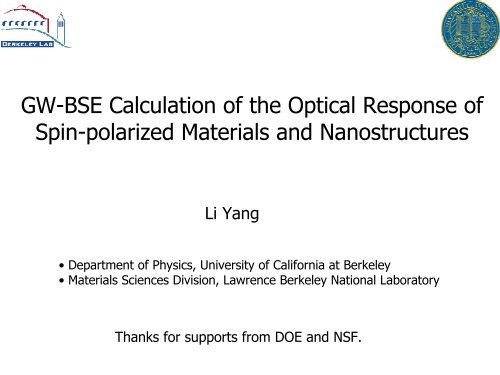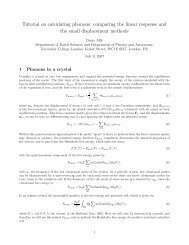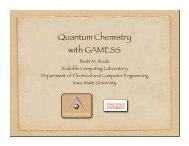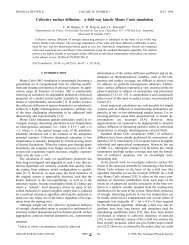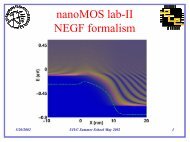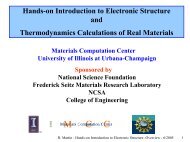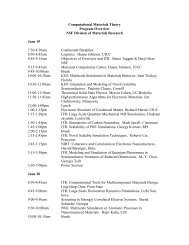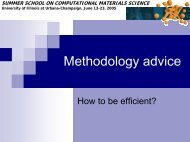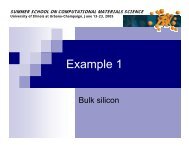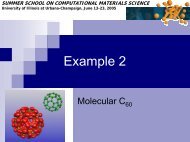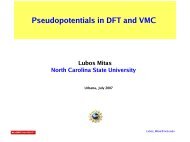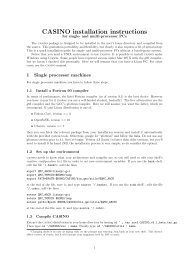GW-BSE Calculation of the Optical Response of Spin-polarized ...
GW-BSE Calculation of the Optical Response of Spin-polarized ...
GW-BSE Calculation of the Optical Response of Spin-polarized ...
Create successful ePaper yourself
Turn your PDF publications into a flip-book with our unique Google optimized e-Paper software.
<strong>GW</strong>-<strong>BSE</strong> <strong>Calculation</strong> <strong>of</strong> <strong>the</strong> <strong>Optical</strong> <strong>Response</strong> <strong>of</strong><strong>Spin</strong>-<strong>polarized</strong> Materials and NanostructuresLi Yang• Department <strong>of</strong> Physics, University <strong>of</strong> California at Berkeley• Materials Sciences Division, Lawrence Berkeley National LaboratoryThanks for supports from DOE and NSF.
Outline• <strong>GW</strong>+<strong>BSE</strong> method with <strong>the</strong> spin degree <strong>of</strong>freedom included.• The optical response <strong>of</strong> spin-<strong>polarized</strong> zigzagedgedgraphene nanoribbons (ZGNRs).• The electronic structure and optical response<strong>of</strong> NiO.
I. An Introduction <strong>of</strong> <strong>the</strong> <strong>GW</strong>+<strong>BSE</strong>Method with <strong>the</strong> <strong>Spin</strong> Degree <strong>of</strong> FreedomIncluded
The Hamiltonian <strong>of</strong> N electrons :Kohn-Sham EquationThe Kohn-Sham formulation <strong>of</strong> density functional <strong>the</strong>ory:with <strong>the</strong> exchange-correlation potential under <strong>the</strong> local density approximation(LDA) or <strong>the</strong> general gradient approximation (GGA). It is very successful todescribe <strong>the</strong> ground state properties <strong>of</strong> solids.For excited states, LDA or GGA systematically underestimates <strong>the</strong> band gap <strong>of</strong>semiconductors and insulators. In addition, <strong>the</strong> optical response is not welldescribed by <strong>the</strong> above method.
Many-body Perturbation Theory(Single-particle Excitations)Quasiparticle (Dyson) Equation:: Self-energy operator; : Quasiparticle energy.Hedin (1965): Perturbation series in screen Coulomb inteaction:Self-energy is evaluated by:
Many-body perturbation Theory(single-particle excitations)Approximations for G and W (Hybertsen and Louie, 1986):• Random phase approximation (RPA) for <strong>the</strong> dielectric function.• General plasmon-pole model for dynamical screening.
Include <strong>the</strong> <strong>Spin</strong> Degree <strong>of</strong>Freedom in <strong>GW</strong>ABy random-phase approximation, <strong>the</strong> static polarizability with spin degree <strong>of</strong>freedom (no spin-orbital interaction included) isSo we only need consider <strong>the</strong> diagonal term in spin space.Pσσ '=⎛ P⎜⎝ 0↑↑P0↓↓⎞⎟⎠The dielectric matrix has <strong>the</strong> form:And <strong>the</strong> bare Coulomb interaction is spin-blind:Therefore, <strong>the</strong> static dielectric function with <strong>the</strong> spin degree <strong>of</strong> freedom includedis given by:, and
Many-body Perturbation Theory(electron-hole excitations)interaction kernel (Onida, et al., 1995; Albrecht, et al., 1997; Rohlfing, et al.,1998; Benedict, et al., 1998)
Include <strong>the</strong> <strong>Spin</strong> Degree <strong>of</strong>Freedom in <strong>BSE</strong>The interaction kernel can be split into two parts, <strong>the</strong> direct termand exchange term (with <strong>the</strong> spin index included):
Include <strong>the</strong> <strong>Spin</strong> Freedom in <strong>BSE</strong>In spin subspace, <strong>the</strong> Hamiltonian isWhere D is <strong>the</strong> quasiparticle energy difference:Therefore, for a spin-<strong>polarized</strong> system, we have to evaluate <strong>the</strong> directand exchange terms with different spin components and diagonalize<strong>the</strong> above Hamiltonian to solve <strong>BSE</strong>.
<strong>Optical</strong> spectrum
II. Quasiparticle Energies and ExcitonicEffects <strong>of</strong> Graphene Nanoribbons
Graphene Nanoribbons (GNRs)Hongjie Dai, et al., Science express, (2008).P. Avouris, et al., Physica E, 40, 228 (2007)P. Kim, et al., PRL, 98, 206805 (2007)
Zigzag-edged GNRs (ZGNRs)8-ZGNRLSDA<strong>Spin</strong> upN z =. . . . . .1 2 8<strong>Spin</strong> down
Quasiparticle Energies <strong>of</strong> ZGNRs12-ZGNR12-ZGNR• The single-shoot <strong>GW</strong>calculation with <strong>the</strong> spindegree <strong>of</strong> freedomincluded.• Significant self-energycorrections are found inZGNRs.• The calculated effectivemass <strong>of</strong> spin-<strong>polarized</strong>edge state is decreased.• The self-energy correctiondepends on <strong>the</strong>localization <strong>of</strong> electronicstates.
<strong>Spin</strong>-<strong>polarized</strong> edge states inZGNRs<strong>Spin</strong> up<strong>Spin</strong> down
<strong>Optical</strong> Absorption Spectra <strong>of</strong>ZGNRs• The <strong>BSE</strong> is solved withina 1x1x256 k-grid with <strong>the</strong>spin degree <strong>of</strong> freedomincluded.• The spectra aredominated by edge-stateexcitons (E 11 i series)with a significant e-hbinding energy.
Exciton E 111(8-ZGNR)Hole
Exciton E 112(8-ZGNR)Hole
Photo-induced Charge and <strong>Spin</strong>Transfers in ZGNRsphotonexcitonexcitonPhoto-reduction<strong>of</strong>antiferromagnetic orderingAntiferromagnetic ordering• Charge transfer and corresponding spin transfer induced byexcitons formed from spin-<strong>polarized</strong> edge states.• Magnetic ordering reduced by exciting singlet excitons.
III. The Electronic Structure and <strong>Optical</strong><strong>Response</strong> <strong>of</strong> NiO
Structure <strong>of</strong> NiO Crystal• A (Nearly) cubic structure(rocksalt) with a latticeconstant <strong>of</strong> 0.417 nm.• NiO has an antiferro-magnetic insulatingground state below <strong>the</strong>Neel temperture.• The spins <strong>of</strong> Ni atoms areferromagnetically alignedwithin <strong>the</strong> {111} plane,but in antiferromagneticarray along <strong>the</strong> [111]direction.
Review <strong>of</strong> Past ab initio StudiesThe discrepancy between above <strong>GW</strong> calculated result is due to <strong>the</strong> underlyingdifferent approximations, self-consistency, and assumptions used.
GGA Results• We include 3s and 3p as valence electrons for pseudopotential generation.• The direct d-d band gap is around 1.4 eV.• Significant hybridization between <strong>the</strong> Ni 3d and O 2p is found for <strong>the</strong> bands closeto <strong>the</strong> band gap.
<strong>GW</strong> Results• The d – d band gap is increased from 1.4 eV to 4.3 eV.• The d – s band gap is increased from 2.5 eV to 2.9 eV.[Sawatzky, et al., 1984]
Compare with Previous WorksFaleev, et al., 2004This work[Massidda, et al., 1997]Model <strong>GW</strong>LSDA_SC<strong>GW</strong>GGA+<strong>GW</strong>• Significant difference <strong>of</strong> <strong>the</strong> d - s band gap between this workand previous ones.
<strong>Optical</strong> Absorption without e-h• The most prominent absorption peak A is consisted <strong>of</strong> a lot contributionfrom d electron states.
<strong>Optical</strong> Absorption with e-h• Significant excitoniceffects are found in<strong>the</strong> opticalabsorptionspectrum. The mostprominent peak ischanged from 5.1eV to 4.5 eV.• This enhancedexcitonic effect isdue to <strong>the</strong> nature <strong>of</strong>localized d electronstates.
Compare with Experiment• The position <strong>of</strong><strong>the</strong> mostprominent peakin experiment islocated at 4.2eV, while ourcalculated peakis at 4.5 eV.[experiment from Power, et al., 1970]
Summary• The framework <strong>of</strong> <strong>GW</strong>+<strong>BSE</strong> method with <strong>the</strong> spin degree <strong>of</strong>freedom included is introduced.• The optical absorption spectra <strong>of</strong> ZGNRs are found to bedominated by <strong>the</strong> magnetic-edge excitons.• The edge-state excitons are charge-transfer excitons and <strong>the</strong>yinduce a spin-transfer across <strong>the</strong> ribbon at <strong>the</strong> same time.• We have performed <strong>the</strong> spin-<strong>polarized</strong> GGA+<strong>GW</strong> method toobtain <strong>the</strong> quasiparticle band structure <strong>of</strong> NiO, which is in goodagreement with experimental measurements.• Significant excitonic effects are found in <strong>the</strong> optical response <strong>of</strong>NiO, which improve <strong>the</strong> agreement <strong>of</strong> <strong>the</strong> calculated spectrumwith <strong>the</strong> experimental result.
AcknowledgeCollaborators:• Pr<strong>of</strong>. Steven G. Louie (UCBerkeley, advisor)• Pr<strong>of</strong>. Marvin Cohen (UCBerkeley, advisor)• Pr<strong>of</strong>. Young-Woo Son(Konkuk University,Korea)• Cheol-Hwan Park (UCBekeley)• Pr<strong>of</strong>. Mei-Yin Chou (Georgia Tech)• Dr. David Prendergast (LBNL)• Dr. Feliciano Giustino (UCBerkeley)• Dr. Filipe J. Ribeiro (UC Berkeley)• Dr. Georgy Samsonidze (UCBerkeley)• Dr. Emmanouil Kioupakis (UCBerkeley)• Dr. Jaydeep Sau (UC Berkeley)• Dr. Jeff Neaton (LBNL)• Dr. Su Ying Quek (LBNL)• Jack Deslippe (UC Berkeley)


